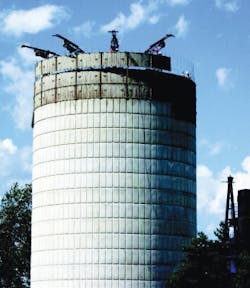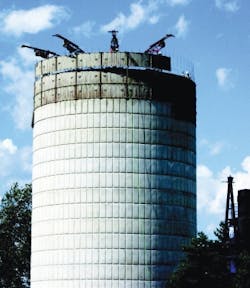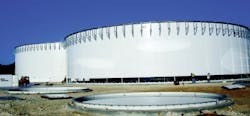Guide to Selecting Liquid Storage Tanks
By Bill Neighbors
In liquid storage containment, quality and value drives today's tank selection process. With advances in fabrication technologies, engineering design, coating processes and field construction techniques, some storage products used in the past have become outdated, while other products have pushed to the "front of the line" in product development and field performance.
The process of selecting a water or wastewater storage tank starts with a series of questions and considerations. This is one of the main problems witnessed in liquid storage containment applications. Many times tank selection is based on a preferred construction type in lieu of field performance requirements. In reviewing different types of tank construction, always remember to start with the field performance requirements, which will lead you to define the "value attributes" of each type of tank construction. In most cases, a review of "value attributes" (the value aspects defined by your client as important, i.e., long life, low maintenance, cost efficient, etc.) and "life cycle costs" will guide and simplify your selection process.
The "top 10" list below includes basic considerations that should be addressed on every liquid storage tank application. If the application under review is routine and no special conditions exist, a standard quotation can be requested from a vendor of choice. If any items listed are a concern, a specialist in liquid storage applications should advise you on the correct approach.
Application Considerations
- Capacity requirements in gallons/cubic meters?
- Project design conditions and applicable codes (AWWA, API 650, NFPA, FM, AISC, NSF, other)?
- Are there any unique "storage process" requirements (agitation, digester, pressure/vac., other)?
- PH and temperature of stored liquid?
- What materials of construction should be used?
- System requirements/ interface responsibility?
- Configuration type (flat bottom, sloped bottom, elevated, other)?
- Corrosion allowance and/or cathodic protection requirements?
- Foundation requirements (concrete ring wall with compacted fill, base setting ring, concrete slab, steel bottom with external saddles, other)?
- Performance guarantee and/or warranty requirements?
You don't need to have all the answers, but you do need to know a reliable storage/containment specialist that can advise you in these areas. With the basics covered, the selection process can be narrowed for customer review and preference.
Tank Styles
In general, water storage applications requiring a volume of less than 90,000 gallons will use a shop-welded or smoothwall bolted tank. Both products are used interchangeably in municipal and industrial applications. Both shop-weld and bolted construction have their own advantages. Under review, the total installed costs (material + freight + field installation) are comparable between both products.
Bolted RTP (rolled, tapered panel), field-weld, concrete and hybrid tank construction are typically used in large volume liquid storage applications. All four designs are routinely specified in the power industry. In industrial and municipal applications, bolted RTP and hybrid steel construction are the most cost efficient tank designs. Field-weld and concrete construction require extended field installation timeframes, which equates to higher installed cost.
Beyond the rhetoric of vendor promotion in the marketplace, when "value attributes" are reviewed and compared to installed costs and life cycle costs, some simple facts become pronounced in ground storage reservoirs:
- Specifying a water or wastewater tank in or below ground . . . the best installed product is concrete tank construction with aluminum dome cover (as applicable).
- Specifying a water or wastewater tank above ground . . . the best installed product is steel tank construction with steel or concrete bottom and aluminum dome cover (as applicable).
- Specifying a cover over a concrete or steel tank . . . the best installed product is an aluminum dome cover.
- Specifying bolted tank construction for water or wastewater storage . . . the best installed product is bolted RTP (rolled, tapered panel) steel tank construction with steel or concrete bottom and aluminum dome cover (as applicable).
- Specifying field welded construction for water and wastewater storage . . . the best installed product is a field welded steel tank sidewall and bottom with aluminum dome cover (as applicable).
Relative to "materials of construction" selection, bolted, shop-weld and field-weld tanks are available in coated carbon steel and stainless steel construction. All tanks are customized for the application and are available for installation at grade level or elevated. Typical tank accessories include manway accesses, level control nozzles, maintenance access platforms, agitators, heaters, insulation, caged ladders, spiral stairways, perimeter guardrails, and custom requirements for system integration.
Conclusion
If the basics are covered in tank selection, years of trouble free containment can be expected. Today, in industrial and municipal storage applications, there are steel storage tanks throughout North America that are over 100 years old. Based on proper maintenance of a storage tank and its coatings, a high quality, properly designed and installed steel storage tank can be maintained for an indefinite service life. Quality and value should drive your future tank selection process.WW
Liquid Tank Selection
Shop-Weld Construction
Applications: Potable water, fire protection, industrial liquids
- Liquid storage up to 90,000 gallons
- Shop-controlled quality/one piece construction
- Shipped in sizes up to 14' dia. x 80' height
- Factory applied coating systems
- Increased freight cost to the jobsite
- Less field installation requirements
Bolted Smoothwall RTP (rolled, tapered panel) Construction
Applications: Water, wastewater, fire protection, industrial liquids
- Liquid storage up to 10 million gallons
- Shop-controlled quality
- Modular construction requires bolted field assembly
- Decreased field installation timeframe
- Factory applied powder coating systems
- Utilizes specialized jacking field construction process
Field-Weld Construction
Applications: Water, wastewater, industrial liquids
- Liquid storage up to 25 million gallons
- Shop-controlled quality - minimize large piece count
- Modular construction requires field welded assembly
- Increased field installation timeframe
- Field applied coating systems
Slip, Jump-Form, Wire-Wound Concrete Construction
Applications: Water, wastewater, composite EWT pedestals
- Liquid storage up to 25 million gallons
- Slip-form quality - high - continuous pour, monolith design
- Jump-form construction - cold joint construction
- Increased field installation timeframe
- Increased foundation requirements
Hybrid Construction (combines bolted RTP, field-weld & concrete construction)
Applications: All types liquid storage
- Liquid storage up to 15 million gallons
- Shop-controlled quality
- Modular construction requires field assembly
- Decreased field installation timeframe
- Factory & field applied advanced coating systems
About the Author:
Bill Neighbors is founder, president and CEO of Tank Connection, an affiliate group of companies that specialize in the design, manufacture and installation of dry bulk and liquid storage systems worldwide. Neighbors is a 25 veteran in storage containment applications. His background includes a BSBA degree from PSU, patented storage designs, advisory board positions and published articles on integrated storage systems. For more information about Tank Connection, visit www.tankconnection.com.
More WaterWorld Current Issue Articles
More WaterWorld Archives Issue Articles



